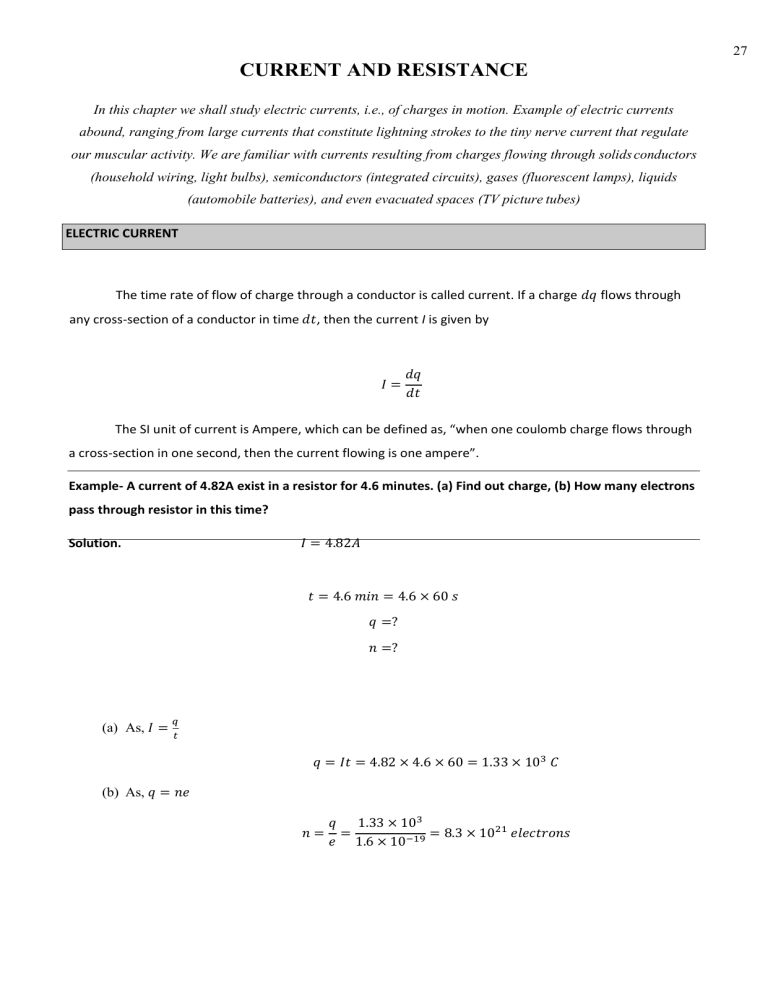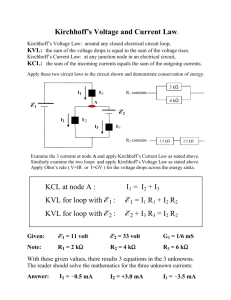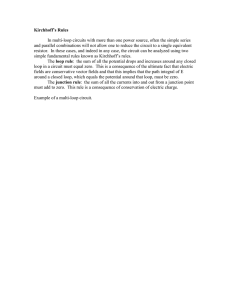
27 CURRENT AND RESISTANCE In this chapter we shall study electric currents, i.e., of charges in motion. Example of electric currents abound, ranging from large currents that constitute lightning strokes to the tiny nerve current that regulate our muscular activity. We are familiar with currents resulting from charges flowing through solids conductors (household wiring, light bulbs), semiconductors (integrated circuits), gases (fluorescent lamps), liquids (automobile batteries), and even evacuated spaces (TV picture tubes) ELECTRIC CURRENT The time rate of flow of charge through a conductor is called current. If a charge 𝑑𝑞 flows through any cross-section of a conductor in time 𝑑𝑡, then the current I is given by 𝐼= 𝑑𝑞 𝑑𝑡 The SI unit of current is Ampere, which can be defined as, “when one coulomb charge flows through a cross-section in one second, then the current flowing is one ampere”. Example- A current of 4.82A exist in a resistor for 4.6 minutes. (a) Find out charge, (b) How many electrons pass through resistor in this time? 𝐼 = 4.82𝐴 Solution. 𝑡 = 4.6 𝑚𝑖𝑛 = 4.6 × 60 𝑠 𝑞 =? 𝑛 =? (a) As, 𝐼 = 𝑞 𝑡 𝑞 = 𝐼𝑡 = 4.82 × 4.6 × 60 = 1.33 × 103 𝐶 (b) As, 𝑞 = 𝑛𝑒 𝑛= 𝑞 1.33 × 103 = = 8.3 × 1021 𝑒𝑙𝑒𝑐𝑡𝑟𝑜𝑛𝑠 𝑒 1.6 × 10−19 28 DIRECTION OF CURRENT In metals, the charge carriers are electrons. But in electrolytes, the current flow due to motion of negative and positive ions. A positive charge moving in one direction is equivalent in all external effects to a negative charge moving in the opposite the opposite direction. Hence for simplicity and algebraic consistency, we adopt the following convention: The direction of current is the direction that positive charges would move, even if the actual charge carriers are negative. Thus, the direction of current is taken from the point of higher potential to the point of lower potential. Even though we assign a direction, current is a scalar quantity, not a vector. The arrow that we draw to indicate the direction of current merely show the sense of charge flow through the wire and is not be taken as a vector. Current does not obey the law of vector addition. Changing the direction of wires does not change the way the currents are added. OHM’S LAW It states that “The current flowing through a conductor is directly proportional to the applied potential difference if all physical states remain same.” If 𝑉 is the potential difference between the ends of conductor and 𝐼 is the current flowing through it, then the Ohm’s law is described mathematically as: 𝐼∝𝑉 𝐼 = 𝐺𝑉 Where, G is the constant of proportionality, sometimes called ‘conductance’. It is related to the resistance by, 𝐺= 1 𝑅 So, 𝐼= 1 𝑉 𝑅 𝑜𝑟, 𝑉 = 𝐼𝑅 Where, 𝑅 is the resistance of the conductor. It is described as the opposition offered by conductor to the flow of current. In system international, its unit is ohm. It is a macroscopic quantity. Its corresponding microscopic quantity is resistivity. 29 Kirchhoff’s Law Kirchhoff’s First Law/Current law: Kirchhoff’s current law states that: ‘The algebraic sum of the currents meeting at any junction in a circuit is zero’. The convention is that, the current flowing towards a junction is positive and the current flowing away from the junction is negative. Let 𝐼1 , 𝐼2 , 𝐼3 , 𝐼4 𝑎𝑛𝑑 𝐼5 be the currents passing through the conductors respectively. According to Kirchhoff’s first law. 𝐼1 + 𝐼2 + (−𝐼3 ) + (− 𝐼4 ) + (−𝐼5 ) = 0 𝑜𝑟 𝐼1 + 𝐼2 = 𝐼3 + 𝐼4 + 𝐼5 i.e., the sum of the currents entering the junction is equal to the sum of the currents leaving the junction. Kirchhoff’s Second Law/Voltage law: Kirchhoff’s Voltage rule is a particular way of stating the law of conservation of energy for a charge carrier travelling in a closed circuit. The Kirchhoff’s second rule is described as: “The algebraic sum of all differences in potential around a complete circuit loop is zero”. ∑𝑉 = 0 Mathematically, [Our sign convention for applying signs to the voltage polarities in our KVL equations will be as follows: when traversing the loop, if the negative terminal of a voltage difference is encountered before the positive terminal, the voltage difference will be interpreted as positive in the KVL equation. If the positive terminal is encountered first, the voltage difference will be interpreted as negative in the KVL equation. We use this sign convention for convenience; it is not required for proper application of KVL, as long as the signs on the voltage differences are treated consistently.] Let’s apply the Kirchhoff’s voltage law for the single circuit loop shown in figure below: Since the two resistors, R1 and R2 are wired together in a series connection, they are both part of the same loop so the same current must flow through each resistor. Thus, the voltage drop across resistor, 𝑅1 = 𝐼𝑅1 and the voltage drop across resistor, 𝑅2 = 𝐼𝑅2 . Now, by KVL: 𝑉𝑠 + (−𝐼𝑅1 ) + (−𝐼𝑅2 ) = 0 30 ∴ 𝑉𝑠 = 𝐼𝑅1 + 𝐼𝑅2 ∴ 𝑉𝑠 = 𝐼(𝑅1 + 𝑅2 ) ∴𝐼= 𝑉𝑠 𝑅1 + 𝑅2 This expression gives the current flow through a circuit containing single loop. Example- Find the current through each battery in the circuit shown below. Solution: Applying Kirchhoff’s 1st law on junction b; 𝐼1 + 𝐼2 + 𝐼3 = 0 ∴ 𝐼3 = −(𝐼1 + 𝐼2 ) Applying Kirchhoff’s 2nd law across the loop abcda; 9 − 18 𝐼1 + 3 𝐼3 = 0 . ⇒ 9 − 18 𝐼1 + 3 (−𝐼1 − 𝐼2 ) = 0 . ⇒ 21 𝐼1 + 3𝐼2 = 9 − − − −(𝑖) Applying Kirchhoff’s 2nd law across the loop dbcd; 3 − 6 𝐼2 + 3 𝐼3 = 0 ⇒ 3 − 6 𝐼2 + 3 (−𝐼1 − 𝐼2 ) = 0 ⇒ 3 𝐼1 + 9 𝐼2 = 3 − − − (𝑖𝑖) Now, 7 × (𝑖𝑖) − (𝑖) ⇒ 60 𝐼2 = 12 ⇒ 𝐼2 = 0.2 𝐴 And, 3 × (𝑖) − (𝑖𝑖) ⇒ 60 𝐼1 = 24 ⇒ 𝐼1 = 0.4 𝐴





